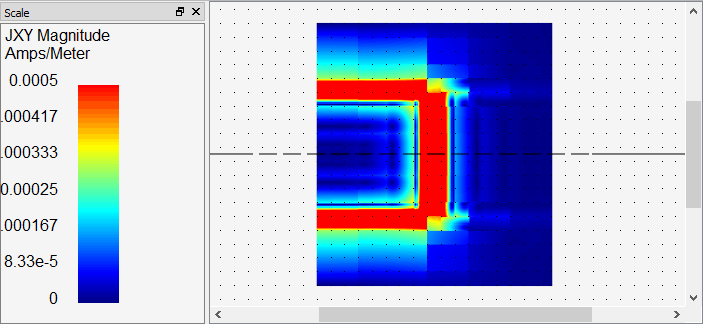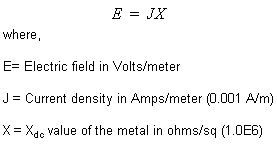One reason em is so fast is that all of the electric and magnetic fields are solved for analytically, with "pencil," "paper" and many equations. The computer need only do an FFT and solve for the current distribution.
However, on occasion, you want to view the fields, not the current. You do this with what is called a "sense layer". The sense layer is a rectangular patch of conductor placed where you want to see the tangential electric field.
Actually, describing the sense layer as a conductor is misleading. This is because you set the surface reactance of the conductor to some large value, say 1,000,000 ohms per square and the surface resistance to zero. You may do this by selecting the Sense Metal definition when defining your metal type in the Metal Editor dialog box. To access this dialog box, select Circuit - Settings from the main menu in the project editor, then click on the Metals/Bricks button in the side bar menu of the Circuit Settings dialog box. In the Metals/Bricks page which appears, click on the Planar metals tab, then click on the Add Planar button. 
You set the reactance to such a large value so that the sense layer has little influence on the original fields. An intuitive analogy is to view a sense layer like inserting a sheet of paper (very high reactance) into the fields. Because the reactance of the sense layer is high, the currents are very small. The sheet of paper does not change the fields.
But even though they are small, what are the currents? The current density is proportional to the tangential electric fields over the area of the sense layer. This is just a two dimensional version of Ohms Law: Current is proportional to Voltage.
An example, tane, is shown below in the current density viewer using a manual scale of 5e-4. You may obtain a copy of this project using the Sonnet Example Browser. For directions on obtaining a Sonnet example, see File - Browse Examples.

The current density plot above shows the tangential electric fields just above a gap discontinuity. The input voltage comes from the left. Strong fields are present across the gap, especially at the corners. This analysis was performed at 1 GHz.
Tane is a good example showing tangential E-field. This circuit uses sense metal set to Xdc = 1.0e6 ohms/square. So, any current on this metal will be proportional to the E-field.
If you view the current density on level 0, you should see the values in the "red" area are about 0.001 Amps/meter. You can click on the circuit and see the value of the current in the status bar at the bottom of the window. Then, simply use the equation (based on Ohms law):

This gives E = 1000 V/ m. This is assuming a voltage at port 1 of 1.0 Volts (default setting).